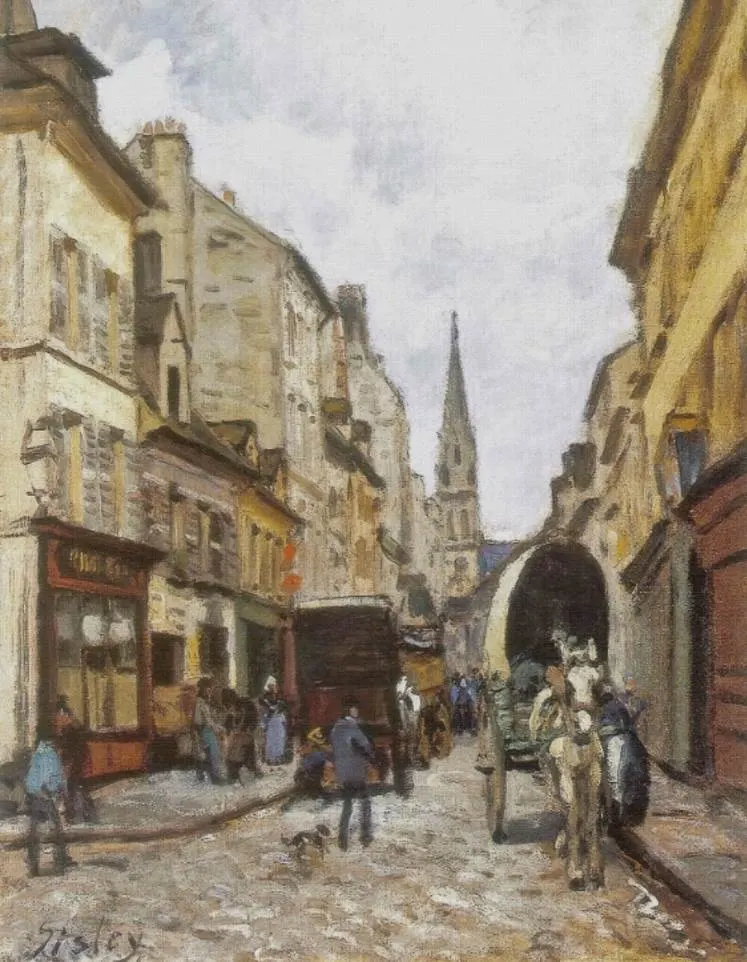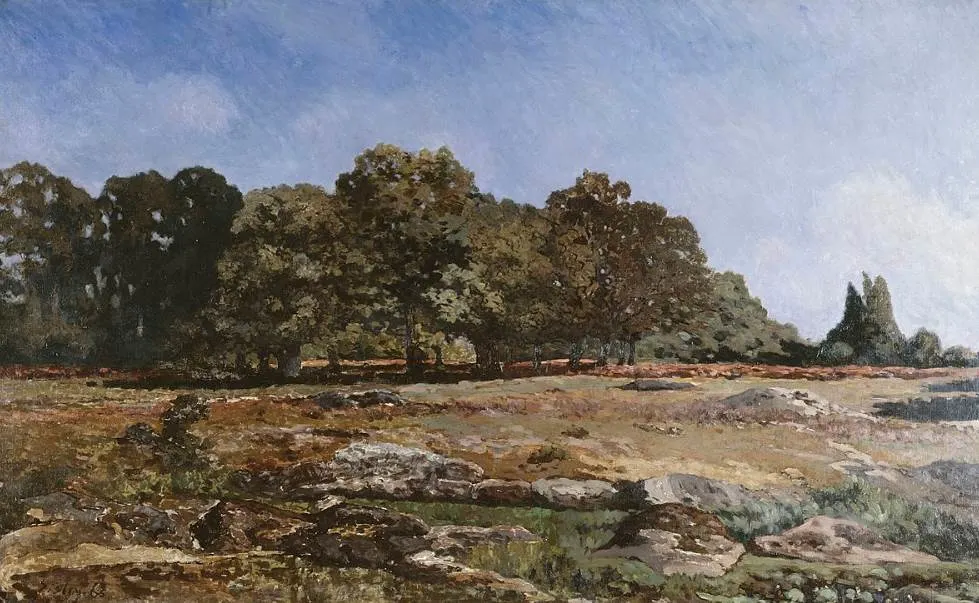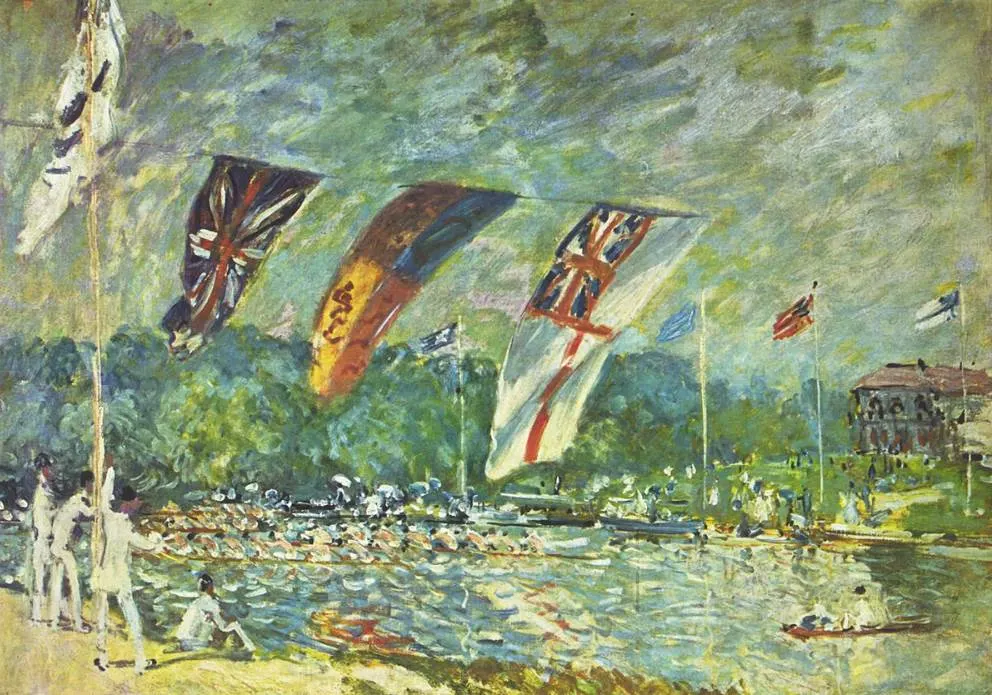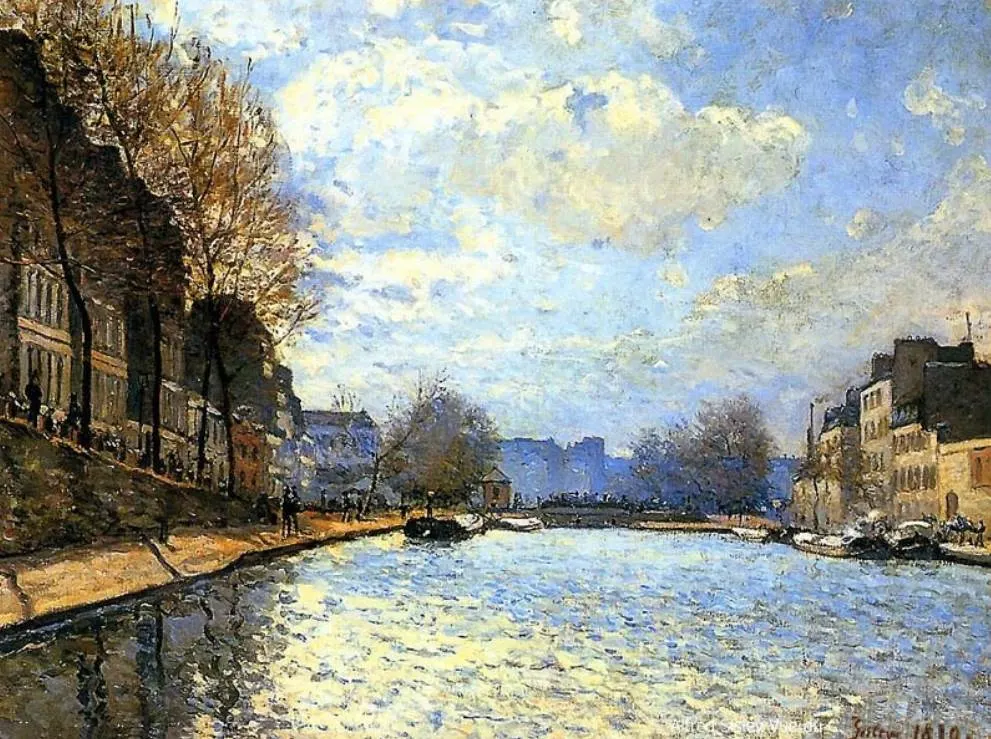This renowned Engish artist was born in Paris and spent most of his career in France. He did, however, retain British citizenship his entire life.
Alfred Sisley (1839-1899) was a landscape painter who thoroughly embraced the Impressionist art movement. He was one of the greatest exponents of painting “En Plein Air” or outdoors.
As an Impressionist artist, he rarely focused on human figures as being the main component of his work. This is unlike other contemporary artists such as Claude Monet and Pierre-Auguste Renoir.
He excelled in landscape painting and stuck to it his entire career. One recurring subject in his oeuvre is bridges which he seemingly enjoyed painting.
Despite spending most of his life in France, he did travel to England and produced some of his most famous paintings here.
In this article, you’ll discover some of the most famous paintings by Alfred Sisley, Impressionist paintings that define this art movement.
1. The Bridge at Villeneuve-la-Garenne
- Date created: 1872
- Dimensions: 49.5 x 65.4 centimeters (19.5 x 25.75 inches)
- Location: MET Museum, New York City, United States
The Bridge at Villeneuve-la-Garenne is one of the many paintings by Alfred Sisley that depict a bridge. In this case, we can see the former cast-iron suspension bridge of Villeneuve-la-Garenne.
The bridge was rebuilt in the early 20th century but according to contemporary photographs, Sisley depicted this scene pretty accurately. The village is located in the northern suburbs of Paris and the bridge connects it with Saint-Denis.

2. Molesey Weir
- Date created: 1874
- Dimensions: 51.1 x 68.8 centimeters (20.11 x 27.08 inches)
- Location: Scottish National Gallery, Edinburgh, Scotland
Molesey Weir is the title of a painting by Alfred Sisley that he produced during his stay in England. It depicts the weir that directs the water of the River Thames into Molesey Lock just west of London.

This painting depicts the view just upstream of Hampton Court Bridge. Ash Island and the northern bank of the River Thames can be seen in the background as Sisley magnificently captured the water gushing through the barrier.

3. Chemin de la Machine, Louveciennes
- Date created: 1873
- Dimensions: 54.5 x 75 centimeters (21.4 x 29.5 inches)
- Location: Musée d’Orsay, Paris, France
Chemin de la Machine, Louveciennes is the title of a painting that depicts a road near the town of Louveciennes. This was a rural village back in the 19th century just north of Versailles and is just about absorbed by the metropolitan area of Paris today.
This village was a popular spot for Impressionist artists. Sisley managed to create a three-dimensional image as the road leads the viewer to the valley. This effect is strengthened by the row of trees along the road. This painting was exhibited at the Exposition Universelle of 1900, the year after Sisley passed away.

4. The Grand-Rue in Argenteuil
- Date created: 1872
- Dimensions: 65 x 46 centimeters (25.5 x 18.1 inches)
- Location: Norwich Castle, Norwich, England
The Grand-Rue in Argenteuil was originally known as “A Street in Sèvres.” As the title suggests, it depicts the main street in the town of Argenteuil, the place where Sisley’s colleague Claude Monet (1840-1926) lived during the 1870s.
The painting is a rather hazy view down this street as we can barely see the spire of the Basilique Saint-Denys d’Argenteuil in the distance. This Romanesque Revival cathedral in the northern outskirts of Paris was only recently completed between 1862 and 1865.

5. A Square in Argenteuil
- Date created: 1872
- Dimensions: 46 x 66 centimeters (18.1 x 25.9 inches)
- Location: Musée d’Orsay, Paris, France
A Square in Argenteuil is a painting by Sisley that is also sometimes referred to as “The Grand-Rue in Argenteuil.” It depicts an alternative view of one of the streets in Argenteuil that leads up to the town’s main cathedral.
It’s one of many paintings that Sisley produced of the town and its surroundings, probably when he was visiting his friend Claude Monet who lived here at the time. Monet produced a very similar painting the same year also titled “Rue de la Chaussée, Argenteuil.”

6. Avenue of Chestnut Trees at La Celle-Saint-Cloud
- Date created: 1865
- Dimensions: 129 × 208 centimeters (51 × 82 inches)
- Location: Petit Palais, Paris, France
Avenue of Chestnut Trees at La Celle-Saint-Cloud is a painting that dates back to the early phase of Sisley’s career. This was a time when the Impressionists were only just emerging and when the English artist still tried to get his paintings approved for the Paris Salon.
This is the reason why it’s a very large painting that has a width of over 2 meters. Despite its monumental size, it was rejected for the prestigious Paris Salon in 1867. The artist did manage to sell this painting, which depicts a small first at La Celle-Saint-Cloud, a decade later to opera singer Jean-Baptiste Faure in 1877.

7. Under Hampton Court Bridge
- Date created: 1874
- Dimensions: 50 x 76 centimeters (19.6 x 29.9 inches)
- Location: The Winterthur Museum of Art, Winterthur, Switzerland
Under Hampton Court Bridge is another painting that Sisley completed during one of his trips to England. He traveled to the country for the first time following the first Impressionist Exhibition in 1874 and painted this work shortly after.
He completed over 20 paintings during this trip and depicted the scenery near East Molesey, a place just southwest of London that is now part of the huge metropolitan area of the city. The painting depicts the third version of the Hampton Court Bridge which was constructed between 1864 and 1865. It was replaced by the fourth and current bridge in 1933.

8. The Terrace at Saint-Germain, Spring
- Date created: 1875
- Dimensions: 73.6 × 99.6 centimeters (29 × 39.2 inches)
- Location: Walters Art Museum, Baltimore, United States
The Terrace at Saint-Germain, Spring is arguably one of the most beautiful landscapes that Alfred Sisley ever produced. It provides a distant view of the Seine Valley at St.-Germain-en-Laye, not too far from Louveciennes where he lived at the time.
The valley is green which emphasizes the fact that he completed this work during the Springtime. The trees are blooming and the river is winding away from Paris on the right. Apart from its beauty, it’s likely that Sisley thoroughly enjoyed painting this work as well.

9. Regatta at Molesey near Hampton Court
- Date created: 1874
- Dimensions: 66 x 91.5 centimeters (25.9 x 36 inches)
- Location: Musée d’Orsay, Paris, France
Regatta at Molesey near Hampton Court is a remarkable painting by Sisyel that depicts a rowing regatta that took place near Molesey. What’s remarkable about this work is that it depicts one of the first editions of this rowing competition as it was only established in 1873.
It was started by an amateur rower the year before Sisley completed this painting and it still exists today. The painting was acquired by Sisley’s colleague and art collector Gustave Caillebotte (1848-1894) who left it to the French state in 1894.

10. The Small Meadows in Spring, By
- Date created: 1881
- Dimensions: 54.3 × 73 centimeters (21.4 × 29 inches)
- Location: National Gallery, London, United Kingdom
The Small Meadows in Spring, By is a painting that depicts a path along the River Seine that connects the small villages of Veneux-les-Sablons and By, just southeast of Fontainebleau. This is quite some distance southeast of Paris and just east of the Fontainebleau Forest.
This walking path has since been paved and we can see the small village of Champagne-sur-Seine appearing on the right side of the painting. The young girl walking on the path is presumably the artist’s daughter Jeanne who was about 12 years old at the time.

11. View of the Canal Saint-Martin
- Date created: 1870
- Dimensions: 50 x 65 centimeters (19.6 x 25.5 inches)
- Location: Musée d’Orsay, Paris, France
View of the Canal Saint-Martin is a painting that depicts the famous canal in the eastern part of Paris. It provides a view as if the viewer is literally standing inside the water which is quite remarkable. Sisley also magnificently captured the shimmering water under the Parisian sun.
The painting was first exhibited at the Paris Salon in 1870 and it was subsequently acquired by a number of art dealers. Dr. Paul Gachet acquired the painting for 170 francs in 1883, a few years before the met his most famous patient Vincent van Gogh (1853-1890).

